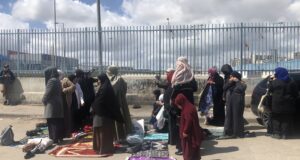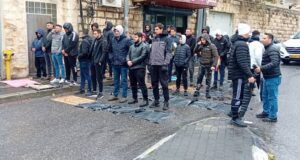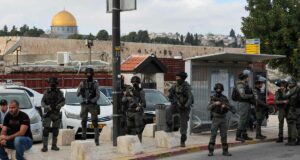International Solidarity Movement
14 February 2010
Sheikh Jarrah resident, 45 year old Fatima Diab was arrested by Israeli police on Saturday evening, February 13, following the provocative appearance of far-right Knesset member Micheal Bin Ari at the Al-Gawi home in solidarity with the extremist settlers occupying the house. Diab was released on a bail of 2000 shekels following an appearance in Jerusalem District Court on February 14.
Tensions were raised in the neighbourhood as MK Bin Ari arrived around 7pm, entering the occupied Al-Gawi house to inspect the state of the settler takeover, accompanied by heightened settler and police presence. Shouting broke out as Bin Ari exited the stolen home, with settlers and Palestinian residents exchanging taunts. Diab, who stood in the crowd, flicked water on Bin Ari as he walked to his car, causing police to immediately demand that she accompany them to the police station for questioning.
Returning home to Sheikh Jarrah at 2am, an exhausted Saleh Diab (brother of Fatima) informed the some ten residents and international solidarity activists assembled for night watch that his sister was being forced to spend the night at the police station. In a split second the entire atmosphere of the neighbourhood had morphed from the relaxed air of the nightly, fire-lit vigil to one of distress and renewed tension. Diab was the first woman of Sheikh Jarrah to be imprisoned.
Diab appeared in the Jerusalem District Court the following afternoon, by which point she was suffering dehydration and exhaustion from her night in an Israeli cell. She was permitted no access to a doctor or medicine until she was finally released around 7pm on the bail of 2000 shekels and was able to return to Sheikh Jarrah. Diab was sentenced to one week of house arrest and is banned from attending the weekly Friday demonstrations in Sheikh Jarrah against settlement expansion in the area.
The incident has only served to exacerbate tensions in the community by the settler takeover, and further highlight the racist and discriminatory nature of Israeli police working in east Jerusalem. Diab herself was burnt by a cup of boiling coffee hurled on her by a settler youth two months ago, who was never reprimanded for the action.
Micheal Bin Ari of the National Union party is known for his position in the Israeli far-right as a provocateur, having been arrested in West Bank settlement demonstrations and protests against Ariel Sharon’s disengagement plan in 2005. Several right-wing Members of Knesset have visited the settler-occupied homes in Sheikh Jarrah in recent months to show their support for the process of ethnic cleansing that is being waged on the Palestinian population.
Background on Sheikh Jarrah
Approximately 475 Palestinian residents living in the Karm Al-Ja’ouni neighborhood of Sheikh Jarrah, located directly north of the Old City, face imminent eviction from their homes in the manner of the Hannoun and Gawi families, and the al-Kurd family before them. All 28 families are refugees from 1948, mostly from West Jerusalem and Haifa, whose houses in Sheikh Jarrah were built and given to them through a joint project between the United Nations Relief and Works Agency (UNRWA) and the Jordanian government in 1956.
So far, settlers took over houses of four Palestinian families, displacing around 60 residents, including 20 children. At present, settlers occupy all these houses and the whole area is patrolled by armed private security 24 hours a day. The evicted Palestinian families, some of whom have been left without suitable alternative accommodation since August, continue to protest against the unlawful eviction from the sidewalk across the street from their homes, facing regular violent attacks from the settlers and harassment from the police.
The Gawi family, for example, had their only shelter, a small tent built near their house, destroyed by the police and all their belongings stolen five times. In addition, the al-Kurd family has been forced to live in an extremely difficult situation, sharing the entrance gate and the backyard of their house with extremist settlers, who occupied a part of the al-Kurd home in December 2009. The settlers subject the Palestinian family to regular violent attacks and harassment, making their life a living hell.
The ultimate goal of the settler organizations is to evict all Palestinians from the area and turn it into a new Jewish settlement and to create a Jewish continuum that will effectively cut off the Old City form the northern Palestinian neighborhoods. On 28 August 2008, Nahalat Shimon International filed a plan to build a series of five and six-story apartment blocks – Town Plan Scheme (TPS) 12705 – in the Jerusalem Local Planning Commission. If TPS 12705 comes to pass, the existing Palestinian houses in this key area would be demolished, about 500 Palestinians would be evicted, and 200 new settler units would be built for a new settlement: Shimon HaTzadik.
Implanting new Jewish settlements in East Jerusalem and the West Bank is illegal under many international laws, including Article 49 of the Fourth Geneva Convention. The plight of the Gawi, al-Kurd and the Hannoun families is just a small part of Israel’s ongoing campaign of ethnic cleansing of the Palestinian people from East Jerusalem.
Legal background
The eviction orders, issued by Israeli courts, are a result of claims made in 1967 by the Sephardic Community Committee and the Knesseth Yisrael Association (who since sold their claim to the area to Nahalat Shimon) – settler organizations whose aim is to take over the whole area using falsified deeds for the land dating back to 1875. In 1972, these two settler organizations applied to have the land registered in their names with the Israel Lands Administration (ILA). Their claim to ownership was noted in the Land Registry; however, it was never made into an official registry of title. The first Palestinian property in the area was taken over at this time.
The case continued in the courts for another 37 years. Amongst other developments, the first lawyer of the Palestinian residents reached an agreement with the settler organizations in 1982 (without the knowledge or consent of the Palestinian families) in which he recognized the settlers’ ownership in return for granting the families the legal status of protected tenants. This affected 23 families and served as a basis for future court and eviction orders (including the al-Kurd family house take-over in December 2009), despite the immediate appeal filed by the families’ new lawyer. Furthermore, a Palestinian landowner, Suleiman Darwish Hijazi, has legally challenged the settlers’ claims. In 1994 he presented documents certifying his ownership of the land to the courts, including tax receipts from 1927. In addition, the new lawyer of the Palestinian residents located a document, proving the land in Sheikh Jarrah had never been under Jewish ownership. The Israeli courts rejected these documents.
The first eviction orders were issued in 1999 based on the (still disputed) agreement from 1982 and, as a result, two Palestinian families (Hannoun and Gawi) were evicted in February 2002. After the 2006 Israeli Supreme Court finding that the settler committees’ ownership of the lands was uncertain, and the Lands Settlement officer of the court requesting that the ILA remove their names from the Lands Registrar, the Palestinian families returned back to their homes. The courts, however, failed to recognize new evidence presented to them and continued to issue eviction orders based on decisions from 1982 and 1999 respectively. Further evictions followed in November 2008 (Kamel al-Kurd family) and August 2009 (Hannoun and Gawi families for the second time). An uninhabited section of a house belonging to the al-Kurd family was taken over by settlers on 1 December 2009.
 International Solidarity Movement Nonviolence. Justice. Freedom.
International Solidarity Movement Nonviolence. Justice. Freedom.


